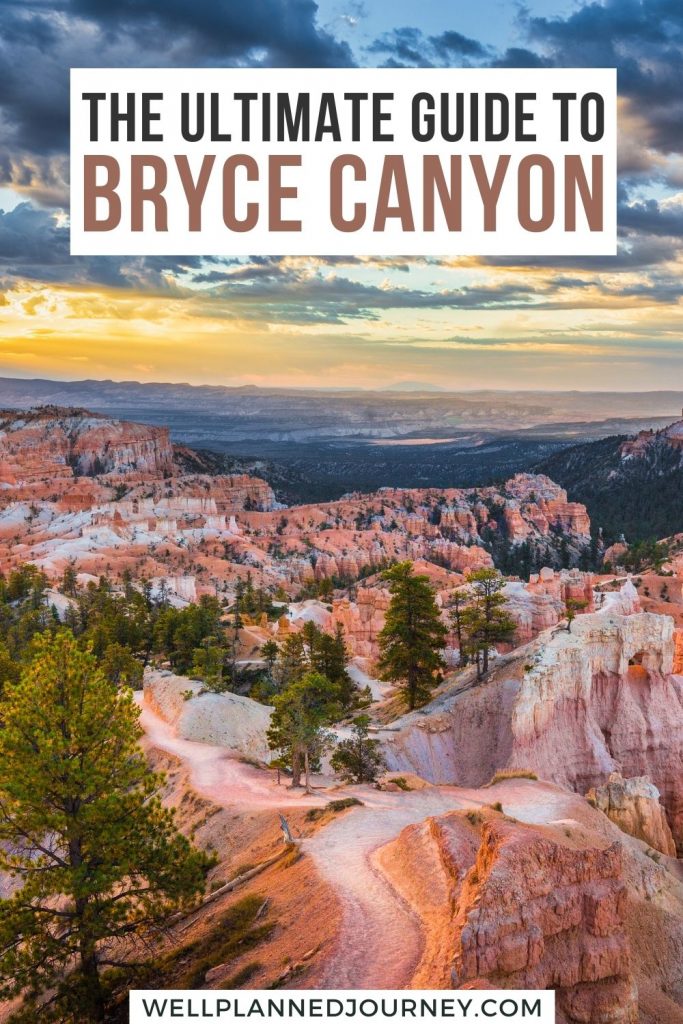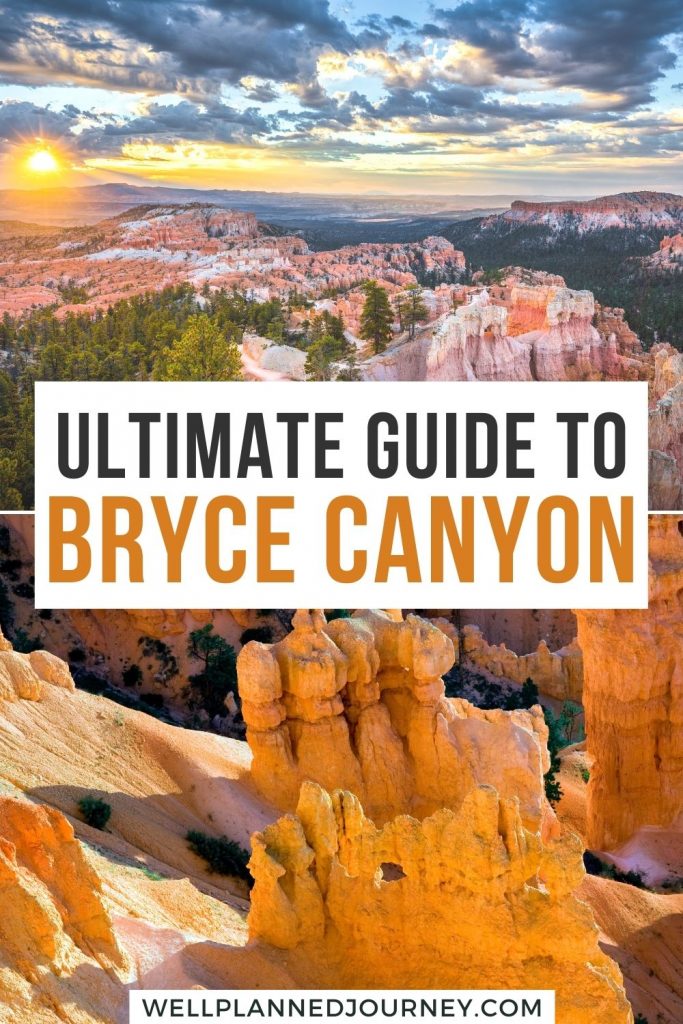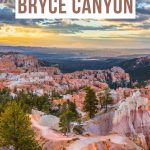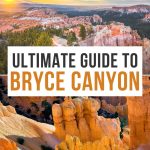Are you planning a trip to Bryce Canyon National Park but don’t know where to start?
With over 2.5 million visitors per year, Bryce Canyon National Park is the second most popular of the “Mighty 5” Utah national parks. Bryce is known for its unique geology and stunning sunrises.
With abundant hikes and scenic drives, there’s no shortage of amazing things to do.
In this guide to Bryce Canyon National Park, I’m sharing tips on when to visit, getting around the park, where to stay, and the best things to do.
Let’s dive in and start planning your trip to Bryce Canyon National Park!
This post may contain affiliate links, where I may receive a small commission at no additional cost to you. Read more in this disclosure policy.
Bryce Canyon At-A-Glance
Before diving in, here are a few highlights to help you plan your trip:
- Best Time to Visit: Spring or Fall are the best times to visit thanks to mild weather, perfect for hiking. Avoid crowds by visiting in March or November, on either end of peak season (just be sure to bundle up as it will be chilly!).
- Where to Stay: If you’re looking to stay in the park, your best option is The Lodge at Bryce Canyon. If you’re looking to stay outside the park, I highly recommend the Best Western Ruby’s Inn in Bryce, Utah (only minutes from the park entrance!).
- How to Get There: The closest airports are in Las Vegas or Salt Lake City, both 4 hours away. Use Expedia to browse flights and find the best price.
- How to Get Around: The easiest way to get around Bryce Canyon is in your own car. Use Expedia to browse deals on rental cars or rent an RV or campervan with Outdoorsy.
- Best Self-Guided Tour: My favorite way to learn more about the park is with GyPSy Guides, a narrated self-guided tour perfect for road trips and scenic drives. The Zion & Bryce Canyon Guide and the Utah “Mighty 5” Bundle both provide incredible commentary and detail about the history and geology of these parks.
- Don’t Forget: Be sure to get an America the Beautiful National Park Pass ahead of time. This $80 pass is valid for 12 months and get you into all 400+ national park sites (including Bryce Canyon!).
Why You Should Visit Bryce Canyon National Park
Bryce Canyon National Park is known for its unique rock formations, called hoodoos. These gravity-defying rocks are formed over millions of years by erosion.
As water freezes, it expands to chip away at plateaus, eventually forming hoodoos.
Hoodoos are found in the southwestern USA, as well as other arid environments around the globe, like Cappadocia, Turkey. Okay… so enough with the geology lesson.
So why should you care about the hoodoos? Well, Bryce Canyon National Park has the largest concentration in the world. Millions of visitors come to see these hoodoos glow in the rising morning sun every year.
Bryce offers a scenic drive to observe the hoodoos from above. Or you can opt for hikes to take you into Bryce Amphitheater (the main park canyon) to observe up close and personal.
Its proximity to other popular parks makes Bryce the perfect stop on a Utah road trip. Many visitors combine a visit to Bryce Canyon National Park with Zion National Park or Grand Staircase-Escalante National Monument.
Visiting Bryce Canyon on a road trip? Don’t miss my two favorite itineraries: 8 days in the Utah national parks and 3 days in Zion and Bryce Canyon.
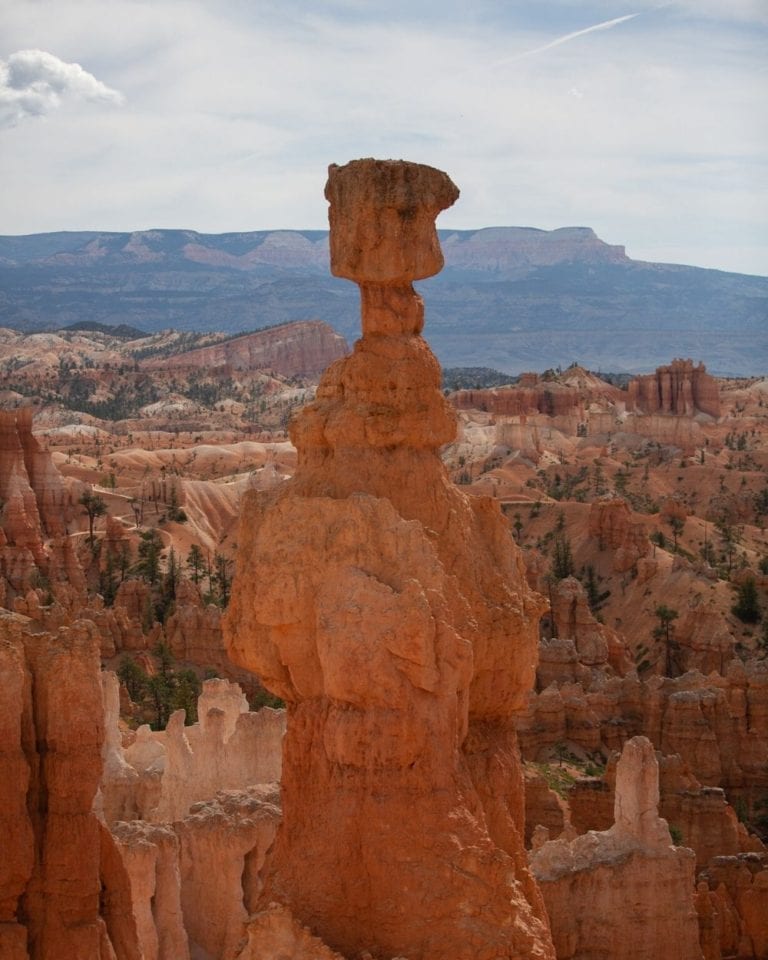
When to Visit Bryce Canyon
Unlike some national parks, winter snow doesn’t shut down Bryce. In fact, there are lots of visitors that prefer to visit Bryce Canyon National Park in the winter.
The contrast between the orangey-red hoodoos and the white snow that blankets them is a sight to behold.
Bryce Canyon National Park gets the most snow out of the Mighty 5 Utah parks, sitting more than 8,000 feet above sea level. Even in the summer, the high elevation makes the park chilly in the mornings.
If you’re looking to hike in Bryce Canyon, I recommend visiting in the late spring or early fall. Visiting in the shoulder months avoids the peak summer crowds.
If you want to photograph snowcovered hoodoos or snowshoe along the rim, I recommend visiting between December and February.
Planning to visit Zion National Park too? Check out this guide on the best time of year to visit Zion National Park.
Getting Around Bryce Canyon National Park
A little over 4 hours from both Las Vegas and Salt Lake City, you can access Bryce Canyon National Park from either airport. If you’re pairing a trip to Bryce with Zion National Park, I recommend flying in and out of Las Vegas.
Bryce Canyon National Park Shuttle
You’ll need a car to get to this remote park, but you can navigate Bryce Canyon National Park without one. The park service offers an optional shuttle during peak season, April to October.
The shuttle starts running at 8 am between the town of Bryce and Bryce Point. Stops include the visitor center, campgrounds, and the famous park lodge.
If you plan to take the shuttle, park at the shuttle stop outside of the park limits in Bryce. This saves you the difficulty of finding parking at the visitor center or the lodge.
While the standard park shuttle doesn’t take you all the way up to Rainbow Point, a reservable tour to Rainbow Point is available twice daily.
You can book the 3.5-hour tour a week in advance at Ruby’s Inn, Ruby’s Campground, the Shuttle parking area, or by calling the park service.
Bryce Canyon Parking and Driving
While the park shuttle is a nice option for those arriving later in the day when parking will be scarce, I prefer the flexibility of having my own vehicle. Plus, you won’t want to miss the sunrise in Bryce Amphitheater.
During the high-visitation summer months, there’s only 1 parking spot for every 4 cars that enter the park. By 9 or 10 am, parking begins to get difficult at popular parking lots, like the visitor center and the lodge.
If you’ll be driving your own car within Bryce, you should get there early. I recommend arriving before sun up for some night sky and sunrise photography.
Bryce Canyon Tip
Start your day in the northern part of the park, exploring the main amphitheater and Bryce Canyon Lodge. Save the southern part of the park, like the drive to Rainbow Point, for later in the day. The late-arrivers circling the parking lot near the lodge will gladly accept your parking spot.
Where to Stay Near Bryce Canyon National Park
This interactive map can also help you search all the available hotels and rental properties near Bryce Canyon National Park! Simply scroll and click the map below to see what is available!
Bryce, Utah
The convenience of staying in Bryce (not to be confused with staying within the park) can’t be beaten. Bryce is only a 5-minute drive from the visitor center and park entrance.
Plus, the park shuttle and tours to Rainbow Point start from the hotels here.
This small tourist haven outside the park offers hotels, restaurants, and RV parks and campgrounds.
I recommend either the Best Western Plus Ruby’s Inn or Best Western Plus Bryce Canyon Grand Hotel (yes there’s two Best Westerns within a quarter-mile).
Ruby Inn’s RV Park and Campground offers full amenities, including a laundromat, hot showers, and a swimming pool and hot tub. You can also reserve cabins at this campground.
Tropic, Utah
If you’re willing to sacrifice park proximity for a more budget-friendly option, consider staying in Tropic. Only 15 minutes from the park, Tropic offers budget motels and inns.
I stayed at the Bryce Canyon Inn – a no-frills, log-cabin-inspired hotel.
The Lodge at Bryce Canyon
Built in 1924, this historic, and rustic, The Lodge at Bryce Canyon is a popular park attraction. With only 114 guest rooms, reserving the lodge as soon as reservations open is essential.
You can book a stay at the lodge 13 months in advance.
For visitors looking for in-park convenience, the lodge can’t be beaten. You’re steps away from Sunrise Point – the perfect spot for viewing sunrise and the night sky.
Camping in Bryce Canyon National Park
Bryce Canyon National Park has two in-park campgrounds – North Campground and Sunset Campground.
North Campground is open all year and is first-come, first-served. Sunset Campground accepts reservations 6-months in advance through Recreation.Gov for May to October.
Sunset Campground is closed in the winter. Both campgrounds have roughly 100 campsites each.
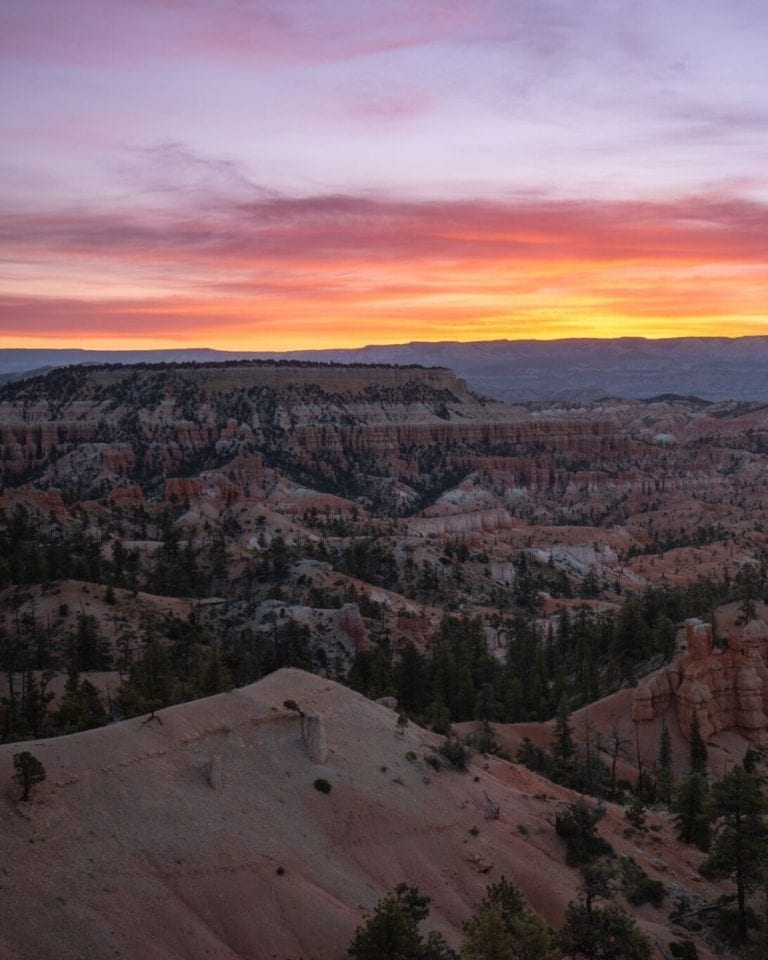
Backpacking In Bryce Canyon
The Under the Rim trail is the signature backpacking experience of Bryce Canyon National Park. This one-way 23-mile hike takes 2-3 days and requires a backcountry permit.
The trail covers the length of the park from Bryce Point up to Rainbow Point. As the name implies, you spend the majority of the hike underneath the rim of the amphitheater amongst the hoodoos.
Permits and Logistics
This trail requires hikers to camp at one of the 8 backcountry campsites. Camping is only allowed in designated areas to preserve the park.
The $5 permit must be obtained in-person at the visitor center up to 48 hours in advance. No phone or email reservations are taken.
Because this is a one-way hike, you’ll need to arrange transportation back from Rainbow Point. The easiest way to do this is through the park-run Rainbow Point Shuttle Tour.
You can book tickets for this before you leave for your hike. Take the shuttle to Bryce Point and back from Rainbow Point.
Don’t miss the best of Utah’s national parks on your upcoming trip! This free, printable Utah national park road trip itinerary covers all the best points of interest in all 5 Utah parks, plus bonus tips on where to stay and side trips to nearby state parks and monuments.
Download your free Utah road trip itinerary here.
Best Hikes in Bryce Canyon
While Bryce Canyon National Park has fewer day hikes than other Utah national parks, there are a few that should be at the top of your list.
Looking for more information about each of these hikes? Check out this guide on the 12 best hikes in Bryce Canyon.
1. Queen’s Garden/Navajo Loop Combination Trail
This popular 2.9-mile hike takes you down into Bryce Amphitheater to get an up-close look at the park’s famous hoodoos. The individual Queen’s Garden and Navajo Loop trails can be combined for a longer loop hike.
Start at Sunrise Point and follow this trail clockwise to end up at Sunset Point. While hiking this direction is a little more strenuous, I think it provides better views.
About a mile into the hike, you’ll come across the Queen’s Garden trail namesake – a rock formation resembling Queen Victoria. As you pass through the amphitheater, admire the rare hoodoos, like the famous Thor’s Hammer.
Before climbing to the amphitheater rim, peer into Wall Street – a deep slot canyon on the Navajo Loop trail.
2. Peek-a-boo Trail
This 5.5-mile loop is a hiker- and equestrian-friendly trail. You’ll start and end at Bryce Point, covering 1,571 feet of elevation gain along your hike.
After the steep descent into the canyon, the loop portion of the trail begins. As you navigate amongst the towering hoodoos, keep a lookout for well-known rock formations like the Wall of Windows.
If you’re looking for a strenuous hike that fully explores Bryce Amphitheater, consider these combination hikes:
- 4.9-mile “Mini Figure 8” (Peek-a-boo + Navajo Loop)
- 6.4-mile “Figure 8 Combination” (Peek-a-boo + Navajo Loop + Queen’s Garden)
3. Sunset-to-Sunrise Point
This flat, paved path overlooks the expansive hoodoo-filled amphitheater. At only 0.5-miles each way, this walk is perfect for those who can’t make the steeper descent to walk amongst the hoodoos.
If you’re completing the Queen’s Garden/Navajo Loop combination, you’ll walk this half-mile along the rim back to your starting point.
4. Mossy Cave Trail
This short 0.8-mile trail off Highway 12 (outside of the main park entrance) follows a stream out to its namesake. The “mossy cave” fills up with icicles in the winter and green moss in the summer.
The contrast between the bright green growth and the glowing red rocks is unique to Bryce Canyon National Park. Continue further along the trail to find a waterfall that fills the stream you followed out.
Read More: 12 Best Hikes in Bryce Canyon National Park

Bryce Canyon Guide to Non-Hiking Things to Do
Compared to other national parks, Bryce Canyon actually has plenty of non-hiking activities, ranging from scenic drives to stunning viewpoints. These are my favorites.
Are you visiting multiple national parks in the next year? The America the Beautiful National Park Pass gets you into 400+ national park sites, including all 63 national parks, for 12 months!
Get your national park pass ahead of time for only $80.
Astronomy & Full Moon Hikes
A trip to Bryce Canyon National Park isn’t complete without seeing the park after dark. As a certified dark sky park, you can see more stars here than almost anywhere in the world.
I recommend arriving at the park about 1-2 hours before dawn and staying for sunrise.
If you’re here during a new moon, you’ll have a good chance of spotting the milky way with your naked eye.
During the full moon, park rangers lead a 1-2 mile full moon hike program. Guided only by moonlight (flashlights aren’t allowed), you’ll walk amongst the spookily-casted hoodoos.
Because the full moon only happens once a month, there’s a high demand for the full moon hikes. Interested parties are required to enter an in-person lottery on the day of the hike.
Everyone in your group should be present at the Bryce Lodge Auditorium for the 4 pm drawing in the summer. In the winter, the lottery takes place at the visitor center for guests to snowshoe under the full moon.
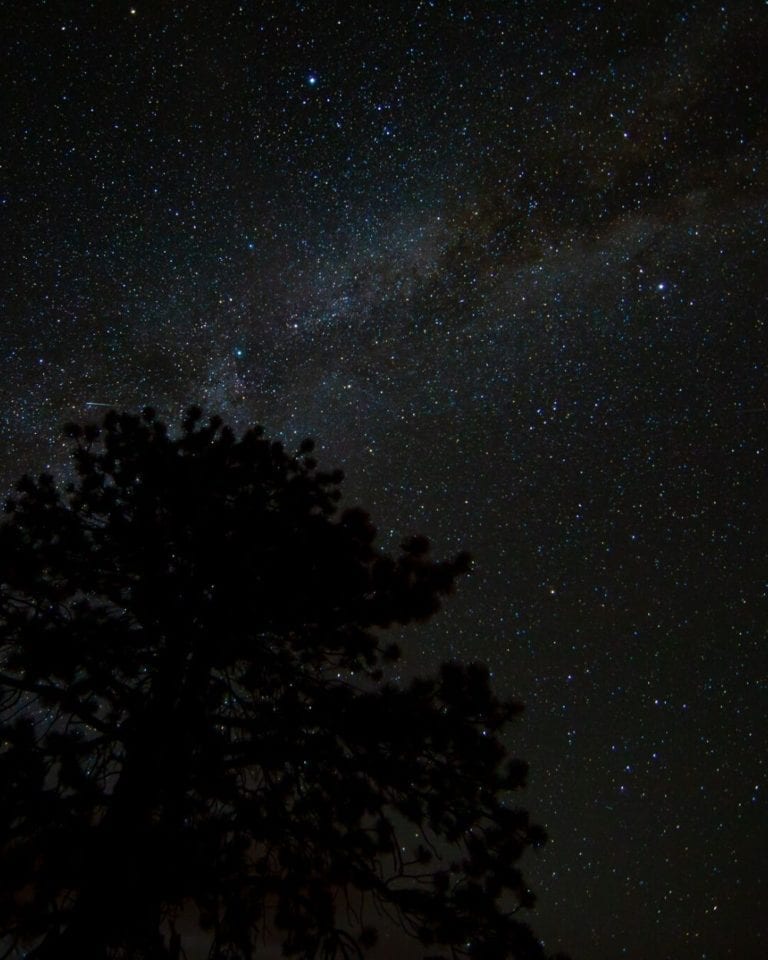
Sunrise at Sunrise Point
If you’re already awake for the night sky, you might as well stick around for sunrise. From Sunrise Point, you’ll watch the sunrise over a distant mountain in the east.
As the sun rises, the hoodoos will illuminate from dark blues to purple, then to pink, and eventually burn a glowing orange.
Walk along the Sunrise to Sunset Point Trail to see the hoodoos reflect the morning light.
Bryce’s Scenic Drive
Bryce Canyon National Park has one main road through the park, from the visitor center up to Rainbow Point.
The 18-mile (each way) drive takes about 3 hours in total and gains 1,221 feet up to Rainbow Point, the highest point in the park at 9,115 feet. The scenic drive includes 15 vantage points of Bryce Amphitheater.
My favorites of the 15 vantage points are Rainbow Point and Bryce Point. But you should stop at all 15 to take in the amphitheater from different perspectives.
Bryce Canyon Tip
I recommend starting in the afternoon once you’ve completed your hikes and sightseeing near the lodge. Parking will be nearly impossible near Sunset and Sunrise Points in the afternoon.
Start by driving all the way to Rainbow Point. All the vantage points are on the eastern side of the road, so it makes the drive easier to start at the top and work your way back down.
Bryce Canyon Tips & Tricks
- Start your day early. Like many national parks, Bryce gets crowded from mid-morning to mid-afternoon. Parking at popular lots, like the visitor center or lodge, is incredibly difficult in the middle of the day. I recommend arriving before sunrise to take in the glowing hoodoos in the morning light.
- Do your hikes in the morning. Start hikes, like the Queen’s Garden/Navajo Loop trail, in the morning to avoid crowds. I recommend watching the sunrise and starting the hike shortly after. Wait to do the scenic drive until the afternoon after you’ve explored the area around Bryce Canyon Lodge.
- Sunrise is the best time for photography. Okay, so maybe this is stating my opinion like a fact, but the warm purples, pinks, and glowing oranges in the amphitheater can’t be missed. Sunrise also avoids photographing shadowed hoodoos in the afternoon and evening sun. I am also more partial to sunrise because there are fewer crowds.
- Bring plenty of water. Bryce Canyon National Park has the highest elevation of the Utah national parks. Plus, you’ll gain over 1,200 feet along the scenic drive! You dehydrate faster at higher elevation, so make sure to drink more water than you normally would. This is particularly important to avoid altitude sickness if you’re coming from lower elevation parks, like Zion. Rainbow Point is 6,000 feet higher than Zion National Park Visitor Center.
- Pack layers. As any savvy hiker knows, layers are your best friend – particularly at Bryce Canyon National Park. As you might have figured out by now ;), the park sits at high elevation. This means it will be cool overnight. When I visited in late May, it was 35 degrees at sunrise. Be sure to carry a pullover at all times to keep you warm.
- Be prepared for thunderstorms. Summer in Utah comes with thunderstorms – which come with lightning. Lightning is dangerous for hikers in Bryce. If you hear thunder, this means lightning is within 10 miles. Seek shelter in a building or vehicle.
Looking for more tips on what to pack for your trip? Check out my guides on the best hiking gear, what to pack for a road trip, and essential camping gear for all my favorite gear picks and tips to make packing for your trip a breeze!
Frequently Asked Questions About Visiting Bryce Canyon National Park
What is the best way to see Bryce Canyon?
The best way to see Bryce Canyon National Park is on a scenic drive. This main road through Bryce Canyon includes more than 15 viewpoints and scenic stops, perfect for seeing the highlights of the park.
How long do you need in Bryce Canyon National Park?
You should plan to spend at least 1 to 2 days in Bryce Canyon National Park. While you can see the highlights in just one day, you’ll be able to explore the hiking trails more with a full 2 days in Bryce Canyon.
Is one day enough for Bryce Canyon National Park?
If you’re only interested in seeing the highlights of Bryce Canyon and doing the scenic drive, one day is enough. If you plan to do some hiking too, I recommend spending 2 days in Bryce Canyon instead.
Do you need a guide for Bryce Canyon?
You do not need a personal tour guide for Bryce Canyon. The park is easy to get around and offers plenty of scenic viewpoints off the main road for those not interested in hiking. If you’re looking for more information on the park, stop in at the visitor center too!
Final Thoughts on This Guide to Bryce Canyon
Bryce Canyon National Park is a popular destination among both backpackers and road trippers. I recommend spending at least 1-2 days in Bryce to soak in all it has to offer. Pair a trip to Bryce with Zion National Park or Grand Staircase-Escalante National Monument.
If you’re only in Bryce Canyon for a day, don’t miss:
- Night Sky and Sunrise at Sunrise Point – the star-filled sky and morning sun on the hoodoos are unbeatable
- Queen’s Garden/Navajo Loop Trail – this popular combination trail gives you an up-close look at the hoodoos
- Scenic Drive to Rainbow Point – explore the 15 viewpoints of the amphitheater along Bryce’s main highway
Looking for more inspiration for your trip to Bryce Canyon? Don’t miss these posts!
- Hiking: 12 Best Hikes in Bryce Canyon
- Visit Zion Too: 3-Day Zion & Bryce Canyon Road Trip
- Utah Road Trip: 8-Day Utah National Parks Itinerary
- All Utah Parks: 14 Best National Parks in Utah
Don’t miss the best of Utah’s national parks on your upcoming trip! This free, printable Utah national park road trip itinerary covers all the best points of interest in all 5 Utah parks, plus bonus tips on where to stay and side trips to nearby state parks and monuments.
Download your free Utah road trip itinerary here.
Don’t Forget to Save This Post on Pinterest
